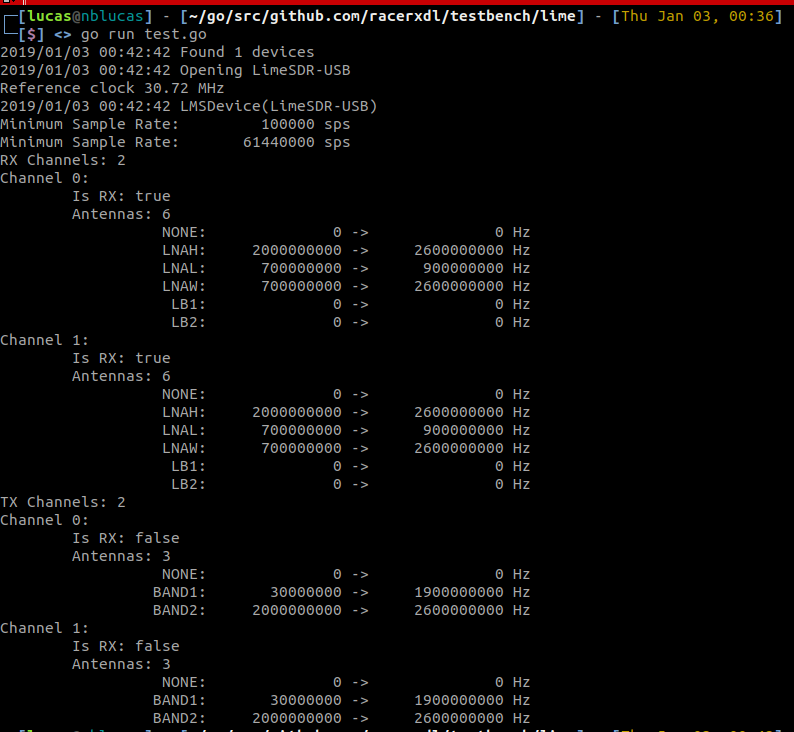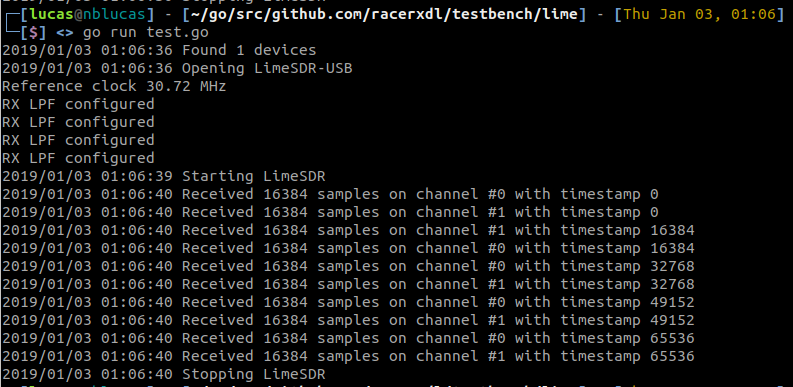Limedrv
What is Limedrv
Limedrv is a libLimeSuite Golang wrapper. It is designed to be easy of use and to be very easily integrated with any type of DSP inside go.
Getting Started
From now on, this article assumes that you know how to setup your golang environment and can build simple hello world programs. If you don't know or never played with GoLang, please refer to: https://golang.org/doc/install
Enumerating Devices
The first thing we need to be able to enumerate all devices that are plugged in. For that, let's create simple program that prints out every lime device that it finds.
package main
import (
"github.com/myriadrf/limedrv"
"log"
)
func main() {
devices := limedrv.GetDevices()
log.Printf("Found %d devices\n", len(devices))
for i, v := range devices {
log.Printf("%d: %s\n", i, v.DeviceName)
}
}
Now we can try to open the device and list its capabilities:
package main
import (
"github.com/myriadrf/limedrv"
"log"
)
func main() {
devices := limedrv.GetDevices()
log.Printf("Found %d devices\n", len(devices))
if len(devices) == 0 {
log.Fatal("No devices found!")
}
d := devices[0]
log.Printf("Opening %s\n", d.DeviceName)
dev := limedrv.Open(d) // Open the selected device
defer dev.Close() // Defer the close of the device
log.Println(dev)
}
Receiving Samples
Receiving data is also simple with limedrv:
package main
import (
"github.com/myriadrf/limedrv"
"log"
)
var stop chan bool
var receivedSamplesChunk = 0
func OnSamples(data []complex64, channel int, timestamp uint64) {
log.Printf("Received %d samples on channel #%d with timestamp %d\n", len(data), channel, timestamp)
receivedSamplesChunk++
if receivedSamplesChunk == 10 {
stop <- true
}
}
func main() {
stop = make(chan bool) // Create Stop Channel
devices := limedrv.GetDevices()
log.Printf("Found %d devices\n", len(devices))
if len(devices) == 0 {
log.Fatal("No devices found!")
}
d := devices[0]
log.Printf("Opening %s\n", d.DeviceName)
dev := limedrv.Open(d) // Open the selected device
defer dev.Close() // Defer the close of the device
dev.SetCallback(OnSamples) // Set Samples Callback
dev.SetSampleRate(3e6, 4) // Set Sample Rate to 2 msps and 4x oversampling
// Get RX Channel 0 (A)
channel := dev.RXChannels[limedrv.ChannelA]
channel.
SetCenterFrequency(106.3e6). // Set Center Frequency
SetAntennaByName(limedrv.LNAW). // Set LNAW Port
SetLPF(1.5e6). // Set LPF to 1 MHz
EnableLPF(). // Enable the LPF
SetGainNormalized(0.2). // Set gain to 0.2 in Normalized value (0 -> 1)
SetDigitalLPF(500e3). // Set Digital LPF (GFIR) to 500kHz
EnableDigitalLPF(). // Enable Digital LPF (GFIR)
Enable() // Enable the RX Channel
log.Println("Starting LimeSDR")
dev.Start()
<-stop // Block main routine waiting for stop signal
log.Println("Stopping LimeSDR")
dev.Stop()
}
You can also enable MIMO (on supported devices) by just enabling the second channel:
dev.RXChannels[limedrv.ChannelA].
SetCenterFrequency(106.3e6). // Set Center Frequency
SetAntennaByName(limedrv.LNAW). // Set LNAW Port
SetLPF(1.5e6). // Set LPF to 1 MHz
EnableLPF(). // Enable the LPF
SetGainNormalized(0.2). // Set gain to 0.2 in Normalized value (0 -> 1)
SetDigitalLPF(500e3). // Set Digital LPF (GFIR) to 500kHz
EnableDigitalLPF(). // Enable Digital LPF (GFIR)
Enable() // Enable the RX Channel channel.
dev.RXChannels[limedrv.ChannelB].
SetCenterFrequency(106.3e6). // Set Center Frequency
SetAntennaByName(limedrv.LNAH). // Set LNAW Port
SetLPF(1.5e6). // Set LPF to 1 MHz
EnableLPF(). // Enable the LPF
SetGainNormalized(0.2). // Set gain to 0.2 in Normalized value (0 -> 1)
SetDigitalLPF(500e3). // Set Digital LPF (GFIR) to 500kHz
EnableDigitalLPF(). // Enable Digital LPF (GFIR)
Enable() // Enable the RX Channel
Transmitting Samples
Currently limedrv only supports RX. But TX support is planned.
| |||||||||||||||||||||



